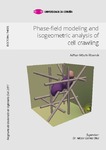Mostrar o rexistro simple do ítem
Phase-field modeling and isogeometric analysis of cell crawling
| dc.contributor.advisor | Gómez, Héctor | |
| dc.contributor.author | Moure, Adrian | |
| dc.date.accessioned | 2017-11-21T17:24:28Z | |
| dc.date.available | 2017-11-21T17:24:28Z | |
| dc.date.issued | 2017 | |
| dc.identifier.uri | http://hdl.handle.net/2183/19781 | |
| dc.description | Programa Oficial de Doutoramento en Enxeñaría Civil . 5011V01 | es_ES |
| dc.description.abstract | [Abstract] A fascinating feature of eukaryotic cells is their ability to move. Cellular motility controls crucial biological processes such as, e.g., cellular nourishment, wound healing, tissue growth, pathogen removal, or metastatic disease. Cell migration through biological tissues is an exceedingly complex process, which is usually understood as a continuous cycle of five interdependent steps, namely: protrusion and elongation of the leading edge driven by actin polymerization; cell-matrix interaction and formation of focal contacts via transmembrane adhesion proteins; extracellular matrix degradation by cell surface proteases; actomyosin contraction generated by active myosin II bound to actin filaments; and detachment of the trailing edge and slow glide forward. Cell migration may be directed by different external stimuli perceived through the cell’s membrane via membrane proteins. Those stimuli, which may take the form of chemical cues or changes in the physical properties of the environment, produce a cellular response that modifies the motile behavior of the cell. Moreover, motile cells may exhibit a number of morphological variants, called modes of migration, as a function of endogenous and exogenous factors such as, e.g., cell-cell and cell-extracellular matrix adhesion, extracellular matrix degradation, orientation of the extracellular matrix fibers, or the predominant cytoskeleton structure. The prominent modes of individual cell migration are mesenchymal, amoeboid, and blebbing motion. Cells can compensate the loss of a particular motile ability by developing migratory strategies, which include the transition between different modes of cell migration. In this thesis we develop three mathematical models of individual cell migration. The models account for the interactions between the cytosolic, membrane, and extracellular compounds involved in cell motility. The motion of the cell is driven by the actin filament network, which is assumed to be a Newtonian fluid subject to forces caused by the cell motion machinery. Those forces are the surface tension of the membrane, cell-substrate adhesion, actin-driven protrusion, and myosin contraction. Also, a repulsive force acting on the cell’s membrane accounts for the interaction with obstacles, which may represent fibers or walls. The models are grounded on the phase-field method, which permits to solve the partial-differential equations posed on the different domains (i.e., the cytosol, the membrane, and the extracellular medium) by using a fixed mesh only. The solution of the higherorder equations derived from the phase-field theory entails a number of challenges. To overcome those challenges, we develop a numerical methodology based on isogeometric analysis, a generalization of the finite element method. For the spatial discretization we employ B-splines as basis functions, which possess higher-order continuity. We propose a time integration algorithm based on the generalized- method. The first model focuses on mesenchymal motion. The model proposes a novel description of the actin phase transformations based on a free-energy functional. The results show that the model effectively reproduces the behavior of actin in keratocytes. The simpler case of cell migration in flat surfaces produces stationary states of motion that are in good agreement with experiments. Also, by considering obstacles, we are able to reproduce complex modes of motion observed in microchannels, such as, e.g., oscillatory and bipedal motion. The second model is used to analyze the spontaneous migration of amoeboid cells. The model accounts for a membrane-bound species that interacts with the cytosolic compounds. The model results show quantitative agreement with experiments of free and confined migration. These results suggest that coupling membrane and intracellular dynamics is crucial to understand amoeboid motion. We also show simulations of a cell moving in a three-dimensional fibrous environment, which we interpret as an initial step toward the computational study of cell migration in the extracellular matrix. The third model focuses on chemotaxis of amoeboid cells. The model captures the interactions between the extracellular chemoattractant, the membrane-bound proteins, and the cytosolic components involved in the signaling pathway that originates cell motility. The two-dimensional results reproduce the main features of chemotactic motion. The simulations unveil a complicated interplay between the geometry of the cell’s environment and the chemoattractant dynamics that tightly regulates cell motility. We also show three-dimensional simulations of chemotactic cells moving on planar substrates and fibrous networks. These examples may constitute a first approach to simulate cell migration through biological tissues. | es_ES |
| dc.language.iso | eng | es_ES |
| dc.rights | Atribución-NoComercial-SinDerivadas 3.0 España | es_ES |
| dc.rights.uri | http://creativecommons.org/licenses/by-nc-nd/3.0/es/ | * |
| dc.subject | Eucariotas | es_ES |
| dc.subject | Células madre mesenquimatosas-Migración | es_ES |
| dc.subject | Análisis isogeométrico-Informática | es_ES |
| dc.title | Phase-field modeling and isogeometric analysis of cell crawling | es_ES |
| dc.type | info:eu-repo/semantics/doctoralThesis | es_ES |
| dc.rights.access | info:eu-repo/semantics/openAccess | es_ES |
Ficheiros no ítem
Este ítem aparece na(s) seguinte(s) colección(s)
-
Teses de doutoramento [2150]






